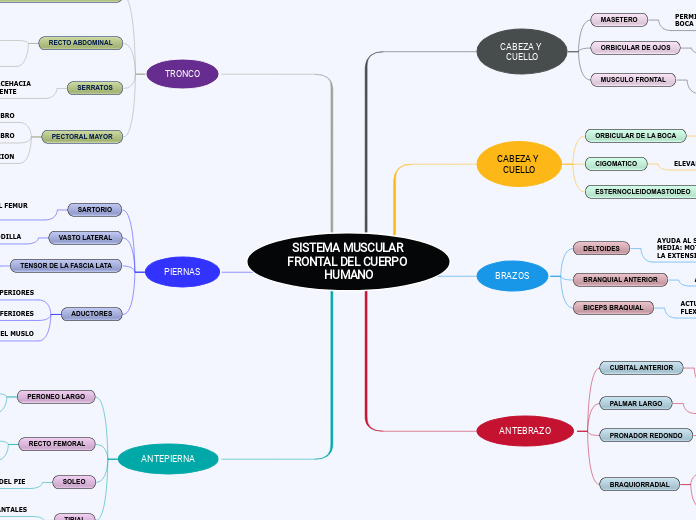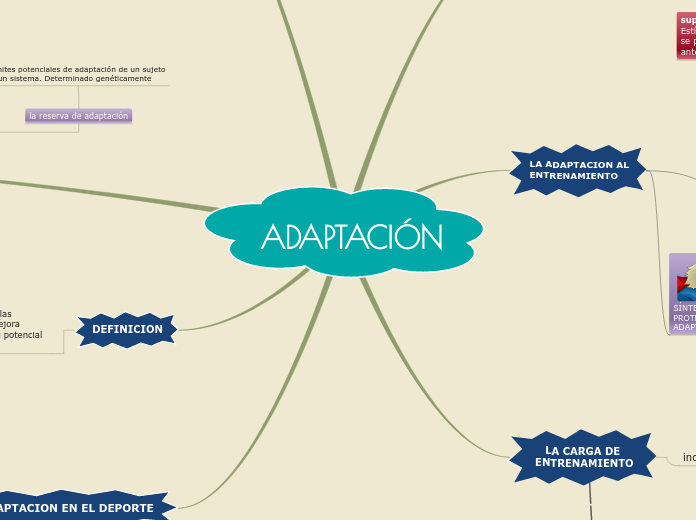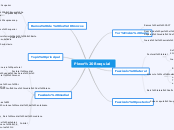SISTEMA MUSCULAR FRONTAL DEL CUERPO HUMANO
The Solar System is the gravitationally bound system of the Sun and the objects that orbit it, either directly or indirectly. Of the objects that orbit the Sun directly, the largest are the eight planets, with the remainder being smaller objects, the dwarf planets, and small Solar System bodies.
ANTEPIERNA
Uranus is an oddball. It has clouds made of hydrogen sulfide, the same chemical that makes rotten eggs smell so foul.
It rotates from east to west like Venus. Its tilt causes extreme seasons that last 20-plus years, and the sun beats down on one pole or the other for 84 Earth-years at a time.
Methane in the atmosphere gives Uranus its blue-green tint. It also has 13 sets of faint rings.
TIBIAL
Uranus has 27 moons that we know of. Five of the moons are large and the rest are much smaller.
Name these 5 moons.
EVITA ARRASTRAR LA PUNTA DEL PIE
ESTABILIZADOR DE LOS ARCOS PLANTALES
SOLEO
How long does it take for Uranus to go around the sun?
FLEXION PLANTAR O EXTENSION DEL PIE
RECTO FEMORAL
A planet's day is the time it takes the planet to rotate or spin once on its axis.
Write down Uranus's day measured in Earth days.
EXTIENDE LA PIERNA EXTENSOR DE RODILLA
FLEXIONAR DESDE EL MUSCULO HACIA EL TRONCO
PERONEO LARGO
ABDUCCION Y ROTACION EXTERNA DEL PIE
MOVIMIENTO DE EVERSION DEL PIE
PIERNAS
Neptune is about the size of Uranus and is known for supersonic strong winds.
Neptune is far out and cold.
The planet is more than 30 times as far from the sun as Earth.
Neptune was the first planet predicted to exist by using math, before it was visually detected. Neptune is about 17 times as massive as Earth and has a rocky core.
ADUCTORES
Neptune has thirteen moons that we know of and one more waiting for confirmation.
The largest moon is slightly smaller than Earth's Moon and has active volcanoes which erupt like geysers and eject nitrogen frost over the surface.
Name this moon and at least 4 others.
EXTENSION DEL MUSLO
ROTACION MEDIAL FIBRAS INFERIORES
ROTACION LATERAL FIBRAS SUPERIORES
TENSOR DE LA FASCIA LATA
How long does it take for Neptune to go around the sun?
ESTABILIZA LA RODILLA EN EXTENSION
VASTO LATERAL
A planet's day is the time it takes the planet to rotate or spin once on its axis.
Write down Neptune's day measured in Earth days.
ESTABILIZA LA ARTICULACION DE LA RODILLA
SARTORIO
ES EL FLEXOR DE LA CADERA Y ALEJA EL FEMUR HACIA AFUERA
TRONCO
It was once considered a planet but in August 2006 the International Astronomical Union (IAU) downgraded the status of Pluto to that of “dwarf planet.”
Pluto is unlike other planets in many respects. It is smaller than Earth's moon; its orbit is highly elliptical.
It's a cold, rocky world with a tenuous atmosphere. Pluto is a very active ice world that's covered in glaciers, mountains of ice water, icy dunes, and possibly even cryovolcanoes that erupt icy lava made of water, methane or ammonia.
PECTORAL MAYOR
The dwarf planet Pluto has five moons.
Name these moons.
EXTENSION DE HOMBRO DESDE SU ADUCCION
FLEXION DEL HOMBRO
ROTACION MEDIAL DEL HOMBRO
SERRATOS
A planet's day is the time it takes the planet to rotate or spin once on its axis.
Write down Pluto's day measured in Earth days.
PROVOCA QUE LA ESCAPULA SE DESPLACEHACIA ARRIBA, HACIA ADELANTE Y LATERALMENTE
RECTO ABDOMINAL
How long does it take for Pluto to go around the sun?
LIMITA LA INSPIRACION MAXIMA Y FAVORECE LA EXPIRACION
PRODUCE FLEXION DE LA COLUMNA VERTEBRAL ATRAVES DE LAS COSTILLAS
OBLICUO EXTERNO DEL ABDOMEN
ACTUA REPRIMIENDO LAS COSTILLAS, LOS OBLICUOS FLEXIONAN EL TRONCO Y FLEXIONANLA PARED DEL ABDOMEN
ANTEBRAZO
Mars is a cold, desert-like place covered in dust. This dust is made of iron oxides, giving the planet its iconic red hue.
Mars shares similarities with Earth: It is rocky, has mountains, valleys and canyons, and storm systems ranging from localized tornado-like dust devils to planet-engulfing dust storms.
BRAQUIORRADIAL
Mars has two small moons.
Name these moons.
CUANDO EL BRAZO ESTA PRONADO EL BRAQUIORRADIAL TIENDE A SUPRINAR EL ANTEBRAZO A MEDIDA QUE LO FLEXIONA
FLEXIONA EL ANTEBRAZO A NIVEL DEL CODO
PRONADOR REDONDO
How long does it take for Mars to go around the sun?
AYUDA EN LA PRONACION DEL ANTEBRAZO PERO TAMBIEN REALIZA UNA LIGERA FLEXION DE LA ARTICULACION DEL CODO
PALMAR LARGO
A planet's day is the time it takes the planet to rotate or spin once on its axis.
Write down Mars's day measured in Earth days.
FLEXOR PRINCIPAL DE LA MUÑECA, PERO CON TENDENCIA A LA ABDUCCION DE ESTA
CUBITAL ANTERIOR
REALIZA LA FLEXION DE LA MUÑECA EJECUTA LA DESVIACION DE LA MANO HACIA EL LADO DEL MEÑIQUE CUANDO LA ARTICULACION SE ENCUENTRA EN POSICION NEUTRA
BRAZOS
Earth is a water world, with two-thirds of the planet covered by oceans.
It's the only world known to harbor life.
Earth's atmosphere is rich in nitrogen and oxygen.
Its name originates from 'Die Erde,' the German word for 'the ground.'
Earth may once have had two moons, nowadays it has just one.
BICEPS BRAQUIAL
How long does it take for Earth to go around the sun?
ACTUA EN LA FLEXION DEL CODO, AYUDA A LA FLEXION DEL HOMBRO.
BRANQUIAL ANTERIOR
A planet's day is the time it takes the planet to rotate or spin once on its axis.
Write down the Earth's day in hours.
ACTUA COMO FLEXOR EN LA FLEXION DEL BRAZO
DELTOIDES
AYUDA AL SISTEMA RESPIRATORIO, PORCION MEDIA: MOTORA PRIMARIA DE LA ABDUCCION Y LA EXTENSION VERTICAL
Venus is Earth's twin in size and has no moons.
Its surface has various mountains and volcanoes. Because of its thick, toxic atmosphere that's made of sulfuric acid clouds, Venus is an extreme example of the greenhouse effect. The average temperature on Venus' surface is 900 F (465 C).
Venus spins slowly from east to west, the opposite direction to most of the other planets.
The Greeks believed Venus was two different objects — one in the morning sky and another in the evening. Because it is often brighter than any other object in the sky, Venus has generated many UFO reports.
ESTERNOCLEIDOMASTOIDEO
How long does it take for Venus to go around the sun?
PERMITE EL GIRO E INCLINACION LATERAL DE LA CABEZA
CIGOMATICO
A planet's day is the time it takes the planet to rotate or spin once on its axis.
Write down Venus's day measured in Earth days.
ELEVADOR Y ADDUCTOR DE LA COMISURA LABIAL
ORBICULAR DE LA BOCA
RODEA LA BOCA Y PERMITE FUNCIR Y CERRAR LOS LABIOS
CABEZA Y CUELLO
Mercury is the smallest, only a little bit larger than Earth's moon. Mercury has no moon.
It experiences dramatic changes in its day and night temperatures: Day temperatures can reach a scorching 840 F (450 C), which is hot enough to melt lead. Meanwhile, on the night side, temperatures drop to minus 290 F (minus 180 C).
It also has a very thin atmosphere of oxygen, sodium, hydrogen, helium, and potassium and can't break-up incoming meteors, so its surface is pockmarked with craters, just like the moon.
MUSCULO FRONTAL
How long does it take for Mercury to go around the sun?
MUEVE EL CUERO CABELLUDO EN SENTIDO ANTERIOR, ELEVA LAS CEJAS Y ARRUGA HORIZONTALMENTE LA PIEL DE LA FRENTE
ORBICULAR DE OJOS
A planet's day is the time it takes the planet to rotate or spin once on its axis.
Write down Mercury's day measured in Earth days.
UNA PARTE PERMITE ABRIR Y CERRAR LOS OJOS
MASETERO
Our Solar System has eight “official” planets which orbit the Sun.
Each planet is at a different distance from the sun. Name its position.
PERMITE ELEVAR LA MANDIBULA Y CERRAR LA BOCA









